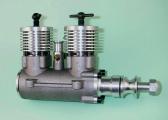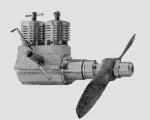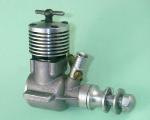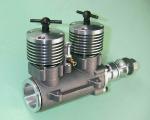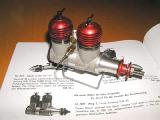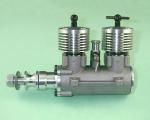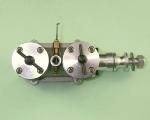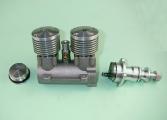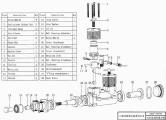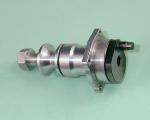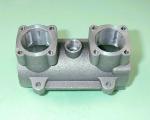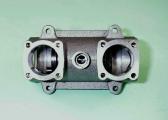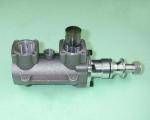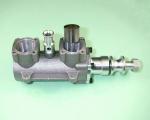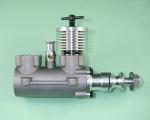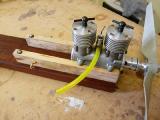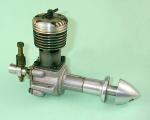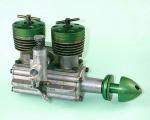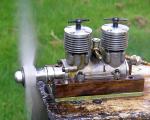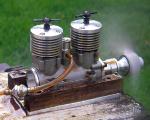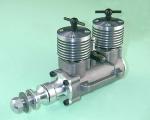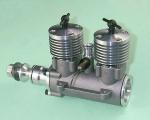The CS "Oliver Twin"
by Adrian Duncan, in collaboration with Maris Dislers
2012-04-22
Revised:
2012-07-01
Among the legendary products manufactured by the famous Oliver workshops during the 1950's were a few in-line twin cylinder diesels which were constructed by the Olivers in prototype form as experiments. These engines were never envisioned as commercial offerings—the cost of their manufacture and the consequently limited number of potential customers doubtless combined to make such a venture appear economically unsustainable. It's not completely clear how many of these prototypes were actually made, but the number cannot have been significant.
The Olivers went on to construct a number of additional twin cylinder prototypes, both in-line and opposed, well into the early 1970's. The Oliver Twins were covered in John Goodall's well-known book on the Oliver engines entitled "The Olivers and a Tiger". Readers wishing to learn more about this very rare series are recommended to this work, which at the time of writing (April 2012) was still available in soft-cover form from the author.
The majority of the Oliver Twins used reed-valve induction, each crankcase having its own reed valve which was supplied with mixture from a common carburettor. However, at least one variant was made which used a form of rotary valve induction. This unit was mentioned in an article by Ron Moulton on the subject of twin-cylinder model engines which appeared in the 1959 "Aeromodeller Annual". The engine appeared to be in effect a twinning of the standard Oliver Tiger Mk. III. It reportedly utilized an ingenious form of surface rotary valve consisting of a central flywheel having a radial port formed in its outer edge which fed the two crankcases alternately.
However, that was about as far as it went at the time. Ron Moulton characterized the engine as "a beautiful project too expensive to repeat in numbers", and the engine was consigned to the status of legend, with no realistic expectation of any interested individual ever being able to acquire one. Apart from its mention in John Goodall's book, little further attention has since been paid to this very interesting design.
All that changed in early 2011 when the CS company of Shanghai, China, released an in-line twin cylinder diesel based on their long-established CS Oliver Tiger 2.5cc model. The latter engine is loosely based upon the Mk. III Oliver Tiger and has found users all over the world (including myself). If well prepared, it can give a "real" Oliver a good run for its money!
Over the past two decades or so, CS have produced an astonishing array of replicas of classic model engines from such brand-names as Micro Diesel, Deezil, AMCO, Rivers, Elfin, Mills, E.D. and of course Oliver. Generally speaking, these have followed the original design configuration fairly closely but have displayed detail departures which render them somewhat less than faithful replicas. They have also displayed quite wide variations in quality. However, the better examples have been found to give good service if well prepared prior to use.
This being the case, the news that CS had actually produced a run of in-line diesel twins based upon their own CS Oliver "replica" caused quite a stirring of interest! I was quick to get my hands on an example with the objective of analysing and testing it to see how well CS have met the undeniable challenge of making such a relatively complex product. Fortuitously enough, my friend and colleague Maris Dislers also took the plunge at about the same time. I am thus able to include a number of Maris's always-valued observations in the present article. My sincere thanks to Maris for this collaborative effort.
The first question that anyone asks when the subject of the CS "Oliver Twin" comes up is—how accurate a replica is it of the original Oliver Twins? The answer may be given very directly—it isn't a replica at all! Although it's based on CS's own "replica" of the Mk. III Oliver Tiger, it's quite unlike any in-line twin that the Oliver family ever produced. In reality, it doesn't appear that CS themselves ever saw this as anything more than an in-line twin cylinder diesel of their own design based in large part upon components which were already in production. The official name of the engine on the company website is the CS OT Twin 30—no overt mention of Oliver there, although the OT presumably stands for Oliver Tiger.
So we're not dealing here with a replica of one of John Oliver's legendary twins—rather, we're looking at CS's own rendition of an inline alternate-firing twin-cylinder diesel based on one of their existing productions. Anyone hoping to acquire a replica of a genuine Oliver Twin is doomed to disappointment. If we were asked to point towards an earlier diesel twin which might have influenced the design of this engine, we would probably think of the Alag 5cc twin of 1958, which was based upon the 2.5cc Alag X-3 single-cylinder unit. The general design layout of the CS twin appears to follow that of the earlier Alag model in many respects.
That said, this is a very interesting engine indeed which is well able to stand on its own legs and be judged on its own merits. So without further ado, let's get into an examination of what is undoubtedly CS's most ambitious diesel project to date.
General Description
The CS OT Twin 30 arrived in one of CS's standard generic blue boxes with no instructions and indeed no paperwork at all. Upon unpacking, it was immediately apparent that we're dealing here with a rotary valve design as opposed to a reed-valve unit. The engine appears at first glance to consist of a pair of CS's standard Oliver piston-cylinder units mated to a common crankcase casting having a bolt-on front end and a screw-in rear backplate. Bore and stroke of each cylinder are 14.05mm and 16.00mm respectively for a combined displacement of 4.96cc (0.303 cuin.). The engine weighs in at 334 gm (11.8 ounces)—rather hefty for a 5cc unit, and well in excess of the claimed weight of 210gm posted on the CS website at http://www.csmodelengine.com/
Taking the single illustration of the original Oliver Twin in Ron Moulton's 1959 article as our guide, a number of design departures are immediately apparent. Apart from the comparatively "square" cooling jacket profile lifted straight from the single-cylinder CS Oliver model, we also note that the front cover of the CS Twin is a bolt-on unit as compared with the screw-in component apparently used on the original Oliver Twin. Moreover, the intake location is different—the CS version features a vertical intake set between the two cylinders, while the original Oliver model had its intake installed in a near-horizontal orientation on the right side of the case. One consequence of this is that the cylinders of the CS version are necessarily set further apart than those of the Oliver original in order to create space for the upright intake.
The mounting lugs are also different. Those on the original Oliver Twin were simple lugs having parallel sides along their entire length. By contrast, the CS offering features major expansions at the mounting hole locations, with far skimpier lugs joining them. It must be admitted that the original design seems to be the sturdier of the two. That said, several of the later reed valve Oliver Twins used the same lug design as that seen on the CS variant.
One feature that does not excite our admiration is the used of rather soft 3mm Phillips-head screws to retain the cylinders. The front housing is secured by four 3mm Allen-head screws of reasonable quality—why not go the same route for the cylinders? Still, these screws are easily replaced.
In keeping with my usual practise with CS engines, I refrained from even turning the engine over pending a thorough clean-up during the course of my internal inspection. However, the initial impression was that this engine was reasonably well made in most of the key areas. I therefore faced the continuation of my self-appointed task with some confidence!
To learn more about the CS Twin and to prepare it for action, we have to take it apart. Let's get to it ...
Internal Inspection
As I got on with the job of dismantling the CS Twin, it became increasingly apparent that the easiest way to describe the engine's design and construction would be to start with the engine in pieces and follow the stages of reassembly. This is one of those engines that is most easily characterized through a description of its major components as they go together.
I'll confine myself to stating that the engine came apart with no complications. It was no surprise to find a very healthy dose of shop debris inside—this is unfortunately a chronic fact of life with CS engines and explains why I won't so much as turn one over until I've had it completely apart for a thorough cleaning. It's a great pity that CS appear unable to get on top of this issue even after many years in production—they really should be able to do better. They have definitely improved over time in other areas—why not this one? As matters stand, any attempt to run this particular unit without a prior clean would doubtless have led to highly negative consequences. Maris Dislers had exactly the same experience with his example.
Once I had it down to its components, the design became completely clear. A further aid to clarity was the receipt of a factory parts list from Maris Dislers, complete with an exploded view of the engine. Reference to this diagram should help to make the workings of the engine perfectly understandable.
The greatest challenge involved in producing a successful in-line alternate-firing twin cylinder engine, particularly one which is supplied with mixture by a single carburettor, is that of ensuring uniform distribution of mixture between the two cylinders. As mentioned above, the original Oliver Twins mostly used reed valve induction which fed each crankcase on demand, the sole exception being their rotary valve in-line alternate firing model using a central flywheel with suitable porting. The CS Twin adopts neither of these approaches—instead, it uses a form of conventional crankshaft rotary valve induction which is arranged to supply mixture to each crankcase in turn from a single carburettor.
The CS Twin uses two separate but interconnected crankshafts. The front shaft is perfectly conventional, looking in fact very much like the CS Oliver crankshaft with a central 5.5 mm diameter gas passage being retained, presumably to reduce weight. However, the induction port and associated FRV venturi are naturally omitted since they are redundant in this design. The retention of the central passage appears to create a marked difference between the crankcase volumes for the two cylinders, which may be problematic from a mixture distribution standpoint. Maris Dislers chose very logically to plug the central hole in his example with an aluminium alloy dowel, while I elected to test mine initially as supplied. I can always plug the hole later.
The front shaft is supported by a fully machined front housing which incorporates two ball races, exactly like its single cylinder relative. Main journal diameter is 10mm, stepping down to 6mm at the front ball race locating shoulder. The shaft has a counterbalanced crankweb with an integrally-machined crankpin.
Inspection of this assembly revealed the first major glitch in this engine's construction. Both of the ball-races were of the shielded type. This makes a certain amount of sense for the front bearing, since it inhibits the entry of external dust or dirt into the bearing. However, at the rear it makes no sense at all. It's essential that oil be completely free to pass through the rear ball race into the plain bearing section and thence to the front ball race, since in the absence of an FRV induction system this is the sole source of lubricant supply for those bearings. The shield used is quite a close fit—the bearing would retain fuel that was poured into the cage under gravity. The use of such a bearing at the rear is more or less a guarantee of oil starvation for the plain bearing section and the front ball race.
I fixed this in my example simply by popping the shield out of the rear ball race and re-installing it. While I was at it, I did the same for the front bearing to allow the free passage of lubricant and the purging of impurities through the bearing during operation. It would be wise for CS to use unshielded components as the standard fittings, particularly at the rear of the front housing. I'd recommend this modification for any such engine that was going to be run.
The prop driver used with this shaft appears to be the same unit employed on the CS Oliver single cylinder model. It is secured to the shaft with a brass split collar. Oddly enough, no washer is supplied to go along with the aluminium alloy sleeve nut used to attach the prop. I quickly remedied this deficiency on my own example.
The finish of the 5mm diameter crankpins on both shafts may fairly be described as being on the good side of adequate. There's certainly room for improvement, but the two crankpins looked as if they would be up to the job as supplied. Subsequent experience confirmed this impression, as we shall see.
The front crankpin incorporates an extension of reduced diameter (4.38mm in my example) starting just aft of the con rod bearing length. This engages with a 5mm hole in the front web of the central crankshaft assembly, thus constraining the two shafts to turn as one with the crankpins set 180 degrees apart. The fact that the engagement extension on the front crankpin is slightly undersize is presumably intended to allow some leeway to accommodate any slight misalignment between the front and central shafts. I would expect considerable chatter to occur at this point, possible leading to increased play between the shafts as running time builds up.
The central crankshaft is undoubtedly the heart of the CS Twin. It is of composite construction, the rear section incorporating both the 12mm diameter main journal and the rear crankweb with integral 5mm diameter crankpin. The main journal is once again carried in two ball races with a plain bearing section in between. The web which engages with the front crankpin as described earlier is a separate component which is permanently mated to a shoulder machined onto the front of the central shaft.
The structural integrity of the central shaft assembly is the most crucial aspect of the design—the entire success or failure of the engine depends upon it. The design is such that the front web is not subject to bending forces as it would be if the front crankpin were integral with it—a good design feature. It is however subject to cyclic torsional stresses of some magnitude during normal operation. It's unclear how the two components are mated—whether force-fitted, shrunk on or fixed with some kind of high-strength bond. All that can be said is that any failure of this joint would immediately wreck the engine.
In fact, as we went to press with his article, we learned that precisely this failure has been experienced by an Australian OT Twin owner. This occurred during the break-in process and by the owner's own admission, may have been caused by over-compression of one cylinder, a condition which will inevitably increase stress levels in the inter-shaft connection. I'm delighted to be able to report that the company responded immediately to the owner's request for assistance and agreed to repair the engine free of charge upon its return to the factory. However, the incident does highlight the fact that the integrity of this joint is perhaps a little marginal and that consequently great care is required in operation, particularly as regards the handling of the compression control for the rear cylinder. Neither Maris Dislers, nor myself, have so far experienced any problems in this area—let's hope that this happy state of affairs continues.
Our Editor, Ron Chernich, recalls a method of keying the crankweb to a separate shaft by drilling one or two blind holes centered on the join line, tapping them, then inserting an Allen head grub screw with a drop of Locktite for added insurance. This would preclude any possibility of slippage and while it could be performed by an experienced model engineer in a reasonably well equipped shop, the modification would be easier to carry out at the factory before the assembly was inserted in the crankcase.
Another issue which arises from the form of construction adopted is the fact that the central shaft cannot be removed for inspection or servicing of the bearings. Hence this is as far as the disassembly process can proceed. Fortunately, the central shaft bearings in my example felt good, although the front central shaft bearing in Maris's engine reportedly felt a bit lumpy and could have done with a closer inspection if that had been possible. That said, it has held up so far in service (see below).
The rotary valve arrangements are not unlike those adopted during the 1950's for the well-known K&B-Allyn twins, albeit without the split central bearing used in that design. The central shaft is drilled at a diameter of 5.25mm from both ends to a depth which leaves some 5mm of material between the two gas passages formed in this way and thus keeps them completely independent, each feeding one of the two crankcases. Each of the two central gas passages has its own induction port, the two ports being located 180 degrees apart on the journal circumference. The entry points into the two induction ports are axially located at the centre of the journal length so that they both correspond to the centrally-located intake venturi section. In order to keep them communicating independently with their own internal gas passages, they are drilled at what appears to be around a 45 degree angle towards the corresponding ends of the shaft. The points at which they meet their respective gas passages appear to have been cleaned up with a hand-held grinder prior to final assembly.
As stated earlier, the success of the engine will depend to a significant extent upon the matching of the two induction systems to minimize differences in mixture distribution between the two cylinders. My example appears to have been fine-tuned by hand-grinding to some extent in order to match the timings for the two cylinders as closely as possible. Timing is extremely conservative, in part due to the relatively small 5.35mm diameter base of the venturi intake mounting coupled with the 5.50mm diameter induction port openings in the very large 12mm diameter journal. The timing of my example is very closely matched for both cylinders, opening at around 87 degrees ABDC and closing some 18 degrees ATDC for an induction period of only 111 degrees. This is supplemented by a sub-piston induction period of some 20 degrees. With the ultra-conservative induction timing adopted, some degree of sub-piston induction is undoubtedly necessary.
The fact that the induction ports are located at the surface of such a large diameter journal naturally results in quite rapid opening and closing of the ports with an enhanced fully-open dwell period. This effect is accentuated by the 45 degree angle at which the induction ports are drilled since the resulting port openings at the journal surface have an oval shape, further increasing the opening and closing rates. Considering the relatively short induction period provided, the system can clearly use all the help that it can get! In fact, the engine would almost certainly perform better if the crankcase unit were machined prior to assembly to allow significantly earlier opening of the induction system. This could easily be done at the manufacturing stage by milling at the appropriate angle.
The middle portion of the central shaft is clearly a potential point of structural fragility given the fact that it is weakened by the presence of two induction ports as opposed to the usual one. The cyclic torsional stresses generated by the operation of the rear cylinder will necessarily be transmitted through this area of the shaft. The very generous main journal diameter of 12mm along with the relatively modest 5.25mm diameter internal gas passages is clearly a very rational design response to this issue. The fact that all ports are round should also help to minimize any tendency towards the creation of stress concentrations at this always-vulnerable point in any crankshaft rotary valve engine. Provided the material and heat-treatment specifications are appropriate (which they have not always been with CS engines), I would actually expect little trouble at this location. As of the time of writing (April 2012), my expectations have been fulfilled.
So much for the central shaft unit. We've spent a great deal of time examining this feature since it is so fundamentally critical to the engine's design and operation. The rest is more simply told because the balance of the engine really amounts to a pair of standard CS Oliver piston-cylinder-rod assemblies being grafted onto the composite crankshaft assembly already described in detail.
When reassembling the engine, it seems best to start with the front cylinder section. The front housing with its shaft installed is presented to the front crankcase, the front con-rod being fitted to the crankpin on the way in. No gasket is used, reliance being placed entirely upon good metal-to-metal contact. Once this assembly is complete and the bolts tightened down, it's essential to check that the composite shaft assembly turns freely. Mine was very good as received, but Maris had to do a little stoning down of the front crankpin extension to get his example turning over smoothly. A friend of Maris's who bought a similar engine found that while his example was generally well fitted, he had to install a fibre gasket between the front housing and the case to move the front housing forward slightly and thus prevent binding of the two crankshafts at the crankpin.
The intake venturi is most conveniently installed at this stage. It screws into a tapped hole in the upper crankcase between the cylinders. When correctly aligned, it is quite tightly fitted, leading one to suspect that a measure of selective fitting is involved. Either that, or it is drilled after initial tightening and then removed for the milling of the flats on each side for the spraybar and mounting nut. The needle valve assembly appears in fact to be a standard CS Oliver unit. On my example, the needle taper was ground out of true with the needle shaft. Since this would have caused very erratic needle response, I re-ground the taper prior to installation. This is a point worth checking if you want your engine to needle reliably.
The front cylinder can now be fitted. There was a certain amount of flash left in the lower ends of the transfer ports on both of my cylinders, which I naturally removed prior to assembly. A good feature is the inclusion of a small notch on the top of the liner to ensure that if the engine is ever dismantled as mine was, it can be reassembled with the cylinder the same way round. Anyone taking one of these engines apart, especially once it's run in, should note the position of these marks during disassembly and should also mark the pistons and rods for the same reason. Above all, it's essential to keep the front and rear working components together as sets.
Once fully assembled, one can get a feel for the fit of the front piston. Mine felt very good as received, and Maris had a similar experience. It's interesting to note in passing that the engine would undoubtedly run in the form achieved at this stage! It is in effect a 2.5cc rear drum valve single cylinder diesel of conventional type. The opening and closing of the "dead" rear induction port might affect carburetion to a degree, but the engine should run in this state nonetheless. I noted this down as an interesting possibility for later testing...
The rear cylinder assembly is completely conventional, being identical in all respects to that of the CS Oliver single. It goes together in the usual way, with attention once more being paid to the consistent alignment of the cylinder liner using the notch mentioned earlier. Once again, the piston fit in my example seemed to be very good. The engine is completed by the installation of the screw-in rear cover. In typical CS fashion, the rear cover is very effectively sealed through the use of an O-ring.
The exhaust period for both cylinders is set at around 160 degrees. Given the induction timing involved as well as the anticipated speed range, the engine would likely perform better with a somewhat lesser exhaust period, with transfer period reduced to match. An exhaust period of around 140 degrees would almost certainly yield superior results in terms of torque production.
Anyway, there we have it—one cleaned-up and re-assembled CS OT 30 Twin all ready to go! Next question—how does it actually run? Only one way to find out...
The CS Twin On Test
Maris Dislers was the first of the two of us to get his example of the engine onto the bench for a few test runs. Having made a test mounting as shown in the attached image and using a 10x6 Taipan prop, he was successful in getting an immediate start. All that was necessary was a prime in both cylinders.
A few glitches became immediately apparent. The front contra piston was too loose and tended to run back, while the rear contra-piston had the opposite problem—it was too tight! Despite these challenges, Maris got a few runs onto the engine, finding that the needle setting was relatively non-critical. Starting remained perfectly straightforward at all times. Most encouragingly, the exhaust residues showed no sign of the dreaded black coloration which usually means that a con-rod bearing is being burned off. I've seen that before with earlier CS engines ...
After a bit of running, Maris was able to obtain 10,700 rpm on the 10x6 Taipan. Based on the approximate power absorption coefficient developed for that prop over years of testing, this equates to around 0.42 BHP at this speed. Hopefully there was more to come ...The front cylinder seemed to be on full song, but the rear cylinder appeared to be a bit behind, seemingly behaving more like a rich glow-plug motor than anything else. No amount of fiddling with the compression screw would put this right.
Maris noted particularly that when the engine was starved of fuel by pinching the fuel line, the rear cylinder invariably quit first. This seems to imply that mixture distribution between the two cylinders was not completely uniform. It must be said that this is hardly a surprising finding. Evidently the rear cylinder was running leaner than the front one.
Following some more runs, a more serious problem presented itself. During the course of a run, the front bearing galled up and seized in the plain bearing section between the ball races. It will be recalled that I noted the potential for oil starvation of the front bearing due to the use of a shielded rear ball race on the front shaft of my example. Upon inspection, Maris's engine turned out to be similarly equipped, which doubtless contributed to the problem. Naturally, he followed my earlier example in removing the shields from both front bearings.
It appears that this seizure was caused by a combination of oil starvation due to the shielded bearings and a too-close fit between the main crankshaft journal and the plain bearing section of the housing between the ball races. CS are known for this latter characteristic—my otherwise-excellent CS E.D. Mk. IV Hunter replica seized in exactly the same manner during its break-in period. It's really a bit odd that CS didn't incorporate a small cross-drilled hole in the plain bearing section of the Twin's front journal to allow for oil distribution from the central passage in the front shaft. They certainly did so in the case of the E.D. replica, although that didn't prevent the seizure that I suffered with that model.
Maris comments that he has always relieved the fit of the plain bearing section in his own CS Oliver Tiger singles to create a radial clearance of around 0.03 to 0.04 mm (~1 thou.). This apparently improves running significantly. Both Maris and I relieved the rather tight fits in our twins accordingly.
While Maris had his example apart, he also took advantage of the opportunity to fit new con-rods having a 1mm greater length between bearing centres. This resulted in more conservative exhaust port timing of 138 degrees as opposed to the 160 degrees as supplied. As noted earlier, the reduced figure seems far more in keeping with the engine's very conservative induction timing. The longer rods also increased the sub-piston induction period to some 45 degrees, which should certainly help the induction cycle. An incidental benefit of this approach is the reduction in the swing angle of the rods and a consequent reduction in side-thrust loadings.
A further issue noted by Maris during the course of this rebuild was the fact that the front piston was out of round by some 10 microns, resulting in the development of hot spots and dirty running. Maris did what he could to ease this problem and re-assembled the engine. Then it was back to the test stand, where the rebuilt engine proved itself to be a fine starter and runner. After a little running-in to settle the refitted components, the following figures were obtained:
| Propeller | RPM | BHP |
|---|---|---|
| APC 11x6 | 9,100 | 0.429 |
| APC 10x6 | 10,800 | 0.467 |
| APC 10x4 | 12,800 | 0.594 |
| Graupner 9x5 | 12,900 | 0.511 |
It's abundantly clear from these figures that the engine comes nowhere near matching the factory claim posted on the CS website of 1.1 BHP at around 10,500 rpm. Peak power is obviously significantly less and is released at substantially higher rpm. Moreover, Maris's figures are taken from a heavily reworked unit and hence cannot be taken as necessarily representative of an off-the-shelf example.
Having said this, it's only fair to point out that these are actually very impressive results indeed for a twin-cylinder diesel based upon 1950's technology. The performance recorded by Maris would have been considered exceptional for such an engine at that time, being well ahead of such highly-regarded twins from the late fifties and early sixties as the sideport Taplin Twin diesel and the twin rotary-valve D-C Tornado glow-plug model. Even the previously-noted 1958 Alag 5cc twin which appears to be the nearest thing to a true predecessor in design terms only produced a factory-claimed 0.51 BHP at unspecified rpm. In actual fact, Maris's reworked CS twin seems if anything to outperform such iconoclastic designs as the Fox 35 stunt. It would undoubtedly do a creditable job of flying a sport-stunt control-line model designed for engines in the .35—.40 cuin. range. Its main disadvantages would be its weight and its noise characteristics.
Turning now to my own example, I found the engine just as easy to start as Maris had done. A small prime in each cylinder... a few flicks... and away she went. Unlike Maris's engine, the front contra-piston proved to be perfectly fitted while the rear contra was perhaps a little tighter than ideal, but not excessively so.
Vibration levels prove to be very low, as one might expect—the main issue here is the fore-and-aft rocking couple which is unavoidably developed between the two cylinders. The very wide mounting hole spacing is of course well suited to resisting these forces, added to which the engine's mass doubtless helps to absorb vibration.
After a little running the exhaust color cleared up and I briefly saw 10,600 rpm on the Taipan 10x6—very close to Maris's initial finding. However, after about 30 minutes of running things suddenly went seriously pear-shaped. During another break-in run with the engine well on song albeit a tad rich, the rear pot suddenly quit. Clearly a mechanical, so I stopped it immediately. It turned out when I got it home that the gudgeon pin for the rear cylinder had been very marginal for length. I have had previous experience with CS gudgeon pins being too short, so I had checked this. However, I did so without actually removing the pin, and I now think there must have been some junk in the boss which hung up the pin and misled me.
Regardless of the reason, one end of the pin had slipped out of its boss while the engine was running. The result is easily imagined—I lost the rod and the piston, although the bore looked OK. So the engine came apart once again so that a new replica rod and piston could be made and fitted.
I considered following Maris's lead by making two new rods of 1mm greater length than standard, but decided in the event to stay with the stock length so that it would be possible to get some idea of the effectiveness of this modification through a comparison of test results between our two engines. For the same reason, I elected not to plug the central passage in the front shaft even though I believe this to be a promising approach. My engine went back together (for the second time!) in its original design configuration apart from the fact that I had removed the shields from the front shaft ball-races and had also relieved the plain bearing fit for that shaft.
So... back to the test stand! The engine proved to be as easy to start as it had previously, and I had no trouble getting it settled into a nice break-in mode of operation. I put on 30 minutes in 5-minute runs with no problems at all, mainly to break in the new rear piston and rod. At this point, the engine felt superb, encouraging me to try a few props to get an idea of the performance levels being realized at this stage. Results were as follows:
| Propeller | RPM | BHP |
| Taipan 10x6 | 10,500 | 0.391 |
| Taipan 10x4 | 12,200 | 0.465 |
| APC 9x6 | 12,600 | 0.489 |
| APC 9x4 | 13,900 | 0.499 |
The figure for the 10x6 indicates that the engine's performance had not suffered appreciably as a result of my home rebuild. However, there seems to be little doubt that my engine doesn't approach the torque production of Maris's example with its lengthened rods and adjusted timing. It's evident that my engine with its stock timing peaks at between 12,600 and 13,900 rpm since the power developed at these speeds is almost identical. I'd guess around 0.53 BHP at somewhere in the region of 13,400 rpm. Still, plenty of power to fly a model.
It must be said that if anyone had managed to produce a twin-cylinder diesel of this type having this level of performance back when the technology which it embodies was current, it would have been hailed as a major achievement. Hats off therefore to CS for a very impressive design effort! A few tweaks plus some attention to the quality control issue, and they'd have a truly remarkable product here.
Some Handling Tips
There are quite a few videos on You-Tube these days showing people running twin-cylinder diesels of various types. A common denominator in these pieces is the revelation that many owners appear to be working in the dark when it comes to a clear understanding of the somewhat black art of getting the best out of such an engine. Hence it seems worth including some hard-won advice on the management of twin-cylinder diesels. I don't pretend to know it all, and others may well have approaches that work better than mine. I can only share the approach which I myself have found to work effectively over the years.
To begin with, it's necessary first to have a clear understanding of the goals that we're trying to achieve. First, we want to get the engine running at the lowest compression settings on both cylinders that permit smooth and efficient operation without misfiring. This is actually one significant advantage of the use of compression ignition in a twin-cylinder engine—one retains direct independent control of the ignition timing in both cylinders during operation, a facility which glow-plug ignition does not provide.
Second, we have to accept the probability that mixture distribution between the two cylinders is unlikely to be absolutely uniform. This being the case, we want the mixture to be at the optimum setting for the leanest-running of the two cylinders. It's far better to have one spot-on and the other slightly rich than it is to have one correct and the other too lean.
Third key point—do not be tempted to use an electric starter on one of these engines! This is good advice for any diesel, but it's particularly important for a twin-cylinder unit like this in which the consequences of a hydraulic lock in either cylinder could be terminal. Once you've established the settings, this engine is extremely easy to start by hand, so there's no justification whatsoever for the use of a starter.
The first imperative is to make arrangements to mount the engine. Do not be tempted in this case to mount the unit in a conventional test stand using the thinner central portion of the mounting lugs! There simply isn't enough metal there and the overhang is too great—distortion of the case would be a very real possibility. Moreover, the rocking couple between the cylinders would be very poorly resisted, doubtless leading to high vibration levels. Far better to do as Maris and I did and make up a mount using hardwood engine bearers as featured in the illustrations.
Now, let's suppose that we have a CS Twin all set up on the bench ready to test. The engines are clearly not test-run at the factory, so there's no guarantee that they are correctly set as received. In fact, we can almost guarantee that the engine will not be correctly set! How best to proceed?
When tackling twin-cylinder diesels, I always start with the compression settings. Over-compression is the real enemy, so during the rebuild process described earlier (without which I would not so much as attempt to start one of these units), I slacken off compression in both cylinders by pressing the contra-pistons a little further up the bores. Once assembled, I adjust the comp screws so that both cylinders feel the same when the engine is turned over and then screw them down progressively by small increments until the setting on each cylinder "feels" right when the engine is turned over slowly by hand with a prop fitted, something which long experience of diesels allows me to do fairly accurately. Usually the settings reached in this way will be found to be somewhere near correct, and I'll obtain a quick initial start.
If you don't have the experience required to set the compression roughly by "feel", it seems best to work on one cylinder at a time to establish a setting. Leaving the rear cylinder at the low setting established during the rebuild, treat the engine as a single cylinder unit and work on the front cylinder in the normal way as if it was a single-cylinder unit—prime, flick and assess results. Keep screwing the compression down by small increments until the thing begins to fire. Then increase the compression in the rear cylinder until it feels more or less the same as the front one when turned over by hand. The two cylinders should now be somewhere near the correct starting settings. A little more compression in each cylinder (and I do mean a little!) should be all that's required.
Now it's time to connect the tank and fill it with fuel. As far as the needle goes, CS needles are set all over the map, so it's impossible to suggest a setting. It seems best to begin with it open around 5 turns and check that fuel is drawn fairly smartly through from the tank when the engine is turned over by hand with the intake finger-choked. This should be an OK setting for attempting a first start.
From this point on, prime both cylinders before each attempt and increase the compression settings by the same (small) amount each time if required. Make sure before you flick that you haven't over-primed and created a potential hydraulic lock in either cylinder. Actually, this is pretty hard to do given the fact that the balance between the two cylinders encourages the engine to come to rest between flicks with both exhaust ports closed.
Starting is now pretty much the same as with a single-cylinder engine. On my own example with the compression set initially by feel, the engine started immediately and kept on running on the front cylinder only, but a small catch-up increase in the compression setting of the rear pot with the engine still running quickly brought it into action as well.
If the engine starts running but dies almost immediately, open the needle a little and try again. If it starts up but then more or less "slobbers" to a halt with lots of fuel and oil being ejected, it's too rich—close the needle down a little. In this latter case, you can almost certainly dispense with the prime for the next starting attempt, and you may have to back off compression a little in both cylinders.
Once running, things are complicated by the fact that you have two independent compression settings with which to deal. The idea is to get both cylinders firing smoothly and thus contributing equally to the engine's output, using the lowest compression settings that allow this to happen. There's a fair bit of trial and error involved here, and the trick is to make all adjustments in small increments. Some of the adjustments seen on You-Tube make me cringe ...
First try the effect of increasing compression slightly on one cylinder. If the speed picks up, try the same thing on the other pot. A further increase in speed means that you're on the right track. Work on the two cylinders alternately, using small adjustments at all times. Alternatively, if the thing slows down when compression is increased in either cylinder, back off compression on that cylinder!
If you can hear a misfire in the exhaust note (as you probably will at this stage), it's vital to determine which cylinder is the culprit. Looking at the exhaust is a useful indicator—those puffs of white smoke are a dead giveaway—but the tip of a finger held where you can feel the exhaust emissions without getting barbequed is perhaps ever better. You can easily feel the erratic exhaust of a mis-firing cylinder. Try the compression control on that cylinder to see if you can eliminate the misfire that way. If you can't, it's a mixture issue.
Once the thing is running as well as you can get it to using compression alone, it's time to tune the needle valve. Here the issue is that it's highly unlikely that mixture supply between cylinders will be uniform, regardless of the designer's best efforts. So you have to use your eyes as well as your ears. Try the effect of leaning out the mixture. The engine will most likely pick up somewhat. If you can't find a setting at which the engine two-strokes smoothly, it's back to the compression—get it running as well as you can using the needle, and then make small adjustments to both cylinders in turn until best running is achieved. Then go back to the needle once more. There's a lot of trial-and-error here, and the secret is to make small adjustments, alternating between compression and mixture controls.
After a few rounds of this, you should have the engine running more or less misfire-free on both cylinders. Then it's a matter of fine-tuning. Here's where the eyes come in! To find the optimum leaned-out needle setting, screw in the needle until a misfire is heard. One of the cylinders will almost certainly go lean before the other. Which one can readily be determined either from the puffs of white smoke which the lean cylinder will emit or by feeling for the erratic exhaust emissions with a finger-tip (not too close!). Then pull out the needle just a fraction past the point at which the misfire and smoke vanish, and that should be your optimum leaned-out setting on the prop in question. The fact that the other cylinder will be slightly rich in this condition doesn't matter—far better this way than having one pot running lean!
The final step is to optimize the compression settings. With the needle at its now-established lean setting, reduce compression on each cylinder in turn by small degrees until a misfire creeps in and the engine begins to slow down. Then increase slightly past the point at which the misfire disappears, and there you are! Repeat for both cylinders and you should have the engine running at its best on the fitted prop, with a clean exhaust and no misfiring. You can try the effect of marginally increasing the compression settings in turn, but a point will be reached where the engine begins to slow down again, at which point it's definitely time to back off a little! The lowest compression settings at which both cylinders are running efficiently is the goal to aim for.
During the first few runs, keep the needle slightly rich and monitor the state of the oil thrown out by the exhaust. A new engine will normally have a dark coloration to the oil, but this should clear up fairly quickly as the parts become mated to each other. If it persists, and particularly if it has a black polychromatic appearance, note which cylinder is the culprit (unless both are!) and stop the engine immediately for investigation back at home. It may well be that a rod bearing is being burned off—I've had this experience previously with CS engines. If a rod bearing is found to be rapidly working loose, the only cure is a replacement following some attention to the cause of the problem (usually a sub-standard crankpin finish).
I'd recommend a 10x6 airscrew for test-running and break-in. The first 30 minutes or so should be put on in 5 minute runs with the needle a little rich and compression on both cylinders slightly reduced from optimum settings. However, just before stopping it's wise to lean out and optimize compression for around 30 seconds or so. This gets plenty of heat into the pistons, which will thus be put through the heat cycles necessary for a proper break-in with an iron-and-steel piston/cylinder combination like this one. After stopping, allow complete cooling before trying a re-start—this is an absolute requirement for proper heat cycling. Far too many users of classic diesels fail to appreciate the importance of these heat cycles during the initial break-in stages.
For a cold re-start, open the needle a little and increase compression slightly on both cylinders. Allow the engine to warm up, then re-establish the correct running settings. Hot restarts (once the engine is fully broken in) are very easy at running settings. In both cases, a small prime in each cylinder is all that is required.
The overall comment may be made that once the correct settings are established, this engine is actually extremely easy to start, usually needing only one or two flicks following a prime. In fact, I'd rate it as easier to start than a lot of single-cylinder diesels of my personal acquaintance.
Evaluation of Findings
I thought long and hard about the best way to sum up our experiences to date with this engine. I didn't want to be unfair to CS, whose ongoing efforts to bring us replicas of classic model engines are very sincerely appreciated. However, I also had to consider the interests of my fellow model engine enthusiasts out there who may be considering the purchase of one of these units and therefore deserve to be accurately informed regarding the challenges which this engine can undeniably present.
It seems best to begin by saying that in general CS are to be commended for developing this very interesting design. There's no doubt at all that this is a CS original, owing little to any "name brand" design past or present. Setting aside the various issues encountered during this evaluation, the CS OT 30 Twin is a clever and logical design which is fundamentally well executed and performs at levels which would have really turned heads back in the fifties when the technology which the engine embodies was current. CS have succeeded in coming up with a nice-looking unit which starts like a dream and runs very well indeed once fully sorted. Moreover, that sound is worth going a long way to hear! So full marks to CS for coming up with this model in the first place.
However, all is not perfect, as the above account will have shown. Both of the engines examined during the preparation of this article developed serious problems requiring correction, as did a third engine owned by another modeller. Some of these fell into the quality control arena, while others related to design deficiencies.
In terms of quality control, it appears on the basis of this showing that CS need to improve in two areas—inspection and cleanliness during assembly. Deficiencies such as the too-short gudgeon pin in my engine really should not get past the inspection process. This is not an isolated case either—one of my CS Rivers units (which proved to be an excellent engine after sorting) had a similar problem as received. Moreover, there is absolutely no excuse in this day and age for the amount of shop debris found in every new CS engine of my personal acquaintance (and I have a few—I'm a good customer!). I have no doubt at all that CS could (and therefore should) do far better in this respect.
As it is, I would recommend that anyone planning to run one of these engines take it apart all the way (apart from the central shaft assembly) and rebuild it from scratch, paying close attention to the rectification of any structural issues encountered such as gudgeon pin lengths, con-rod clearances, binding between front and rear shafts, etc. Each and every individual component and assembly should be thoroughly inspected and cleaned prior to re-installation. Don't forget to keep the front and rear cylinder assemblies separate!
In terms of design specifications, the most glaring problems seem to be:
- the use of shielded ball bearings which restrict the free flow of lubricant to the bearings as well as the purging of impurities; and
- the excessively tight clearance used in the plain bearing section of the front housing.
I'd recommend as a minimum that any owner having the required technical skills extract the front ball bearings and remove their shields prior to running the engine. The alternative is of course to replace the shielded bearings with unshielded items. I'd also suggest relieving the clearance between the front shaft journal and the plain bearing section between the two front ball races. I believe that both of these steps are necessary to ensure reliability in operation. When reassembling the front end, be sure to include any axial clearance shims which were fitted to the front of the shaft at the factory to maintain correct bearing spacing.
The above steps should result in a dependable unit provided there are no additional issues requiring correction. However, there are other areas in which the engine could almost certainly be further improved. If I had the opportunity to discuss potential design improvements with CS staff, here's what I would recommend:
- Use unshielded ball races throughout for improved lubricant distribution. As noted above, this is one issue that can be addressed by a knowledgeable owner—the bearing shields are easy to remove if you take the correct approach. Alternatively, the stock bearings can simply be replaced with unshielded items. But CS could easily relieve us of the need to do this ...
- Specify a slightly greater clearance for the plain bearing section of the front housing. Around 0.001" seems ideal. Again, this can easily be accomplished by an owner who knows what he's doing. However, CS could readily address this issue during the manufacturing stage.
- Eliminate the central hole in the front crankshaft, thus equalizing crankcase volumes (more or less) between the two cylinders. This being a twin, weight saving is far less important than achieving equal volumetric efficiency for both cylinders. The use of a close-fitting alloy plug is a neat approach which an owner (or indeed the manufacturer) could take to accomplish this objective with little weight penalty.
- Advance the timing of the induction port openings (easy to do at the manufacturing stage by machining the crankcase intake aperture appropriately prior to installation of the shaft). This could in theory be done by an owner with the shaft in place, but it would require great care and could result in irreparable damage if approached incorrectly. In view of the need to maintain adequate strength, I would not recommend enlargement of the induction ports in the central crankshaft.
- Reduce the cylinder port opening periods and increase the sub-piston induction period either by making the con-rods 1mm longer between bearing centres or by machining the deck height of the cylinder location surfaces on the top of the crankcase 1mm lower. The former approach would have the added advantage of reducing the swing angle of the rods and hence the amount of side-thrust. However, it would no longer be possible to use standard off-the-shelf CS Oliver rods, which would have cost implications. The second approach would allow the continued use of standard CS Oliver rods, with the swing angle being unchanged.
Maris Dislers' engine has had all of the above modifications made except for no. 4, and we've seen that it runs very well indeed. If CS could incorporate these design suggestions into the production model and get on top of the quality control issue, they'd have one of the best twin-cylinder diesels ever offered to the modelling public.
In view of the failure which was experienced by another owner with respect to the integrity of the central shaft assembly, I would also recommend that CS re-evaluate that aspect of the design. Although (by the owner's admission) over-compression may have been the primary culprit, this failure does indicate a certain degree of fragility at this point. It may be possible to improve the structural integrity of that assembly in some way. That said, the present design may prove completely adequate in the absence of any mishandling.
Further Experimentation
Following the initial publication of this article, Maris and I both continued our respective testing activities. Unfortunately, we use different test prop sets for the most part, but two figures obtained by Maris were amenable to direct comparison. These were 12,700 rpm on the APC 9x6 and 15,500 rpm on the APC 9x4. The implied outputs at these two speeds were 0.500 and 0.654 BHP respectively.
The most noteworthy differences between our two engines were seen at the top end. As recorded above, my engine managed 12,600 rpm on the APC 9x6—near enough to Maris�s result—but only 13,900 rpm on the APC 9x4. Some further running time to settle down the new piston improved the latter figure to 14,400 rpm, but this was still well short of Maris�s results for that prop.
Discussions between the two of us resulted in the conclusion that the major performance enhancement resulting from Maris�s use of longer rods might well have been the increase in sub-piston induction period. To test this theory, I dismantled my engine once again and turned 1mm off the bottom edge of the piston skirts. This increased the sub-piston induction period to more or less the same as that on Maris�s engine with its standard piston skirts and 1mm longer rods. However, the cylinder port timing of my engine was unaffected.
Upon reassembly, I immediately re-tested the engine. Starting and handling were unaffected by the modification, the engine behaving just as well as ever. Following a 15 minute shakedown period, the following results were obtained:
| Propeller | RPM | BHP |
| Taipan 10x6 | 10,500 | 0.404 |
| Taipan 10x4 | 12,200 | 0.475 |
| APC 9x6 | 12,700 | 0.500 |
| Taipan 9x6 | 12,500 | 0.490 |
| APC 9x4 | 14,700 | 0.591 |
| Taipan 9x4 | 14,200 | 0.561 |
| APC 8-1/2x4 | 15,100 | 0.540 |
The APC 8-1/2 x4 is my own creation intended to fill a gap in my test prop set. It will be noted that there was little improvement in the engine�s performance below 13,000 rpm. However, there was a measurable improvement in the performance achieved with the 9x4 prop. Since power absorption increases as the cube of engine speed for a given prop, the 300 rpm gain on the 9x4 translates into a substantial power increase in the 14,000 rpm speed range. The engine now appeared to peak at around 0.600 BHP in the vicinity of 14,800 rpm—a truly commendable performance for a 5cc diesel, regardless of type.
That said, there seemed to be no question that Maris�s engine with its longer rods remained the superior performer. It�s clear from this that the combination of a longer sub-piston induction period with shorter transfer and exhaust port periods resulting from the use of longer rods is the hot combination here. If I were to advise CS regarding further performance modifications to this engine, I would recommend keeping everything the same apart from the use of rods having a 1mm greater bearing spacing. If that was seen as being too costly from a production standpoint, I�d recommend making the piston skirts 1mm shorter. Both modifications seem to improve performance, although the longer rods clearly have the greater effect. The skirt-shortening modification can easily be carried out by an owner having access to a lathe.
One happy note here was the fact that both Maris�s and my own engines continued to hang in well from a structural standpoint. My own unit had well over an hour of running by this time, much of it at quite high speeds, with no signs of any problems developing Let�s hope that this continues!
Conclusion
So we finally arrive at the inevitable question—would I recommend that my readers rush out to buy one of these engines? Well, if you just want one as a collector's piece for display purposes, go ahead—it's a great-looking item. If on the other hand your ambitions include actually running the thing, then I'd have to qualify my answer rather heavily—by all means go ahead and buy one as long as you're confident of your own technical ability to deal with issues of the kind raised in the above report. Above all, do not buy one of these engines expecting it to run well for you straight out of the box! At the very least, you'll have to take it apart and rebuild it following a thorough inspection and cleaning.
Having said that, I'll come right out and confirm that I'm really glad that I bought mine! Despite the frustration arising from all of the problems encountered, overcoming the various challenges provided hours of entertainment and the end result is a great-looking easy-handling unit that performs very well indeed and sounds fantastic! Certainly turns heads when it fires up! I feel that despite the various issues requiring resolution, I still got very good value for my money.
My overall assessment is that if CS could just get on top of the design issues and quality control challenges discussed above (all of which are manageable), they'd have a real winner on their hands. Let's hope that they read this article and take its well-intended message to heart. I for one wish them very well in their activities and remain very grateful indeed for their ongoing efforts to bring us interesting and unusual products such as this one. This definitely won't be my last CS engine!
